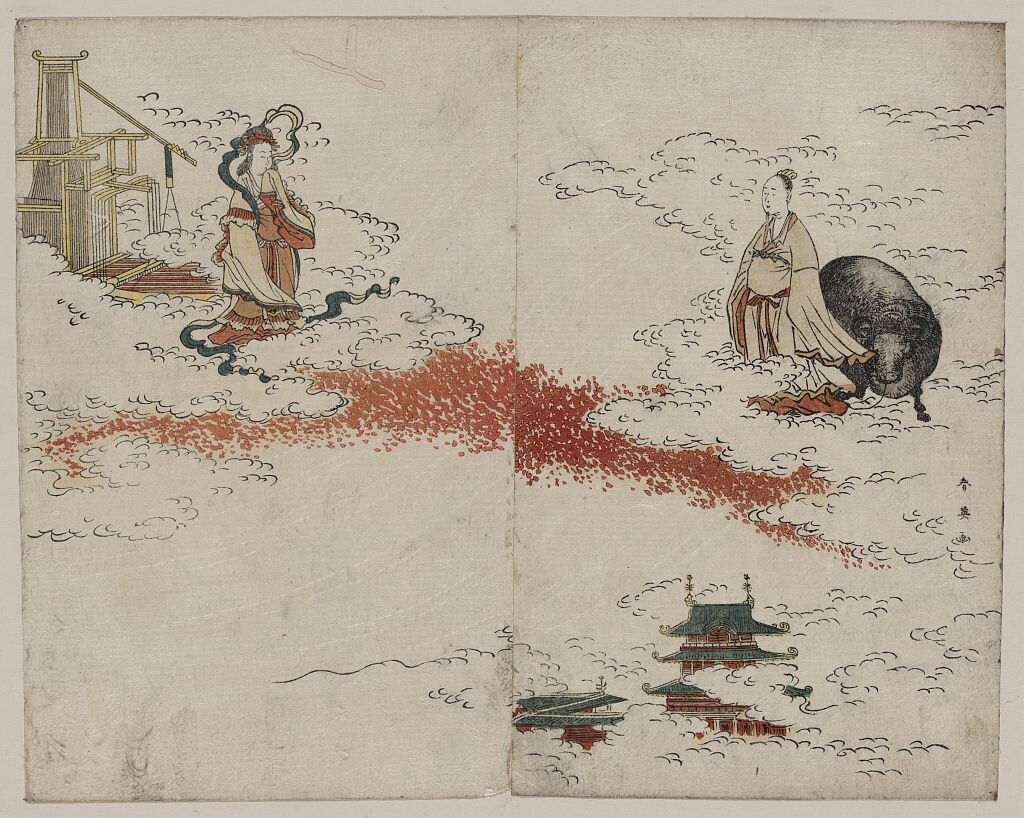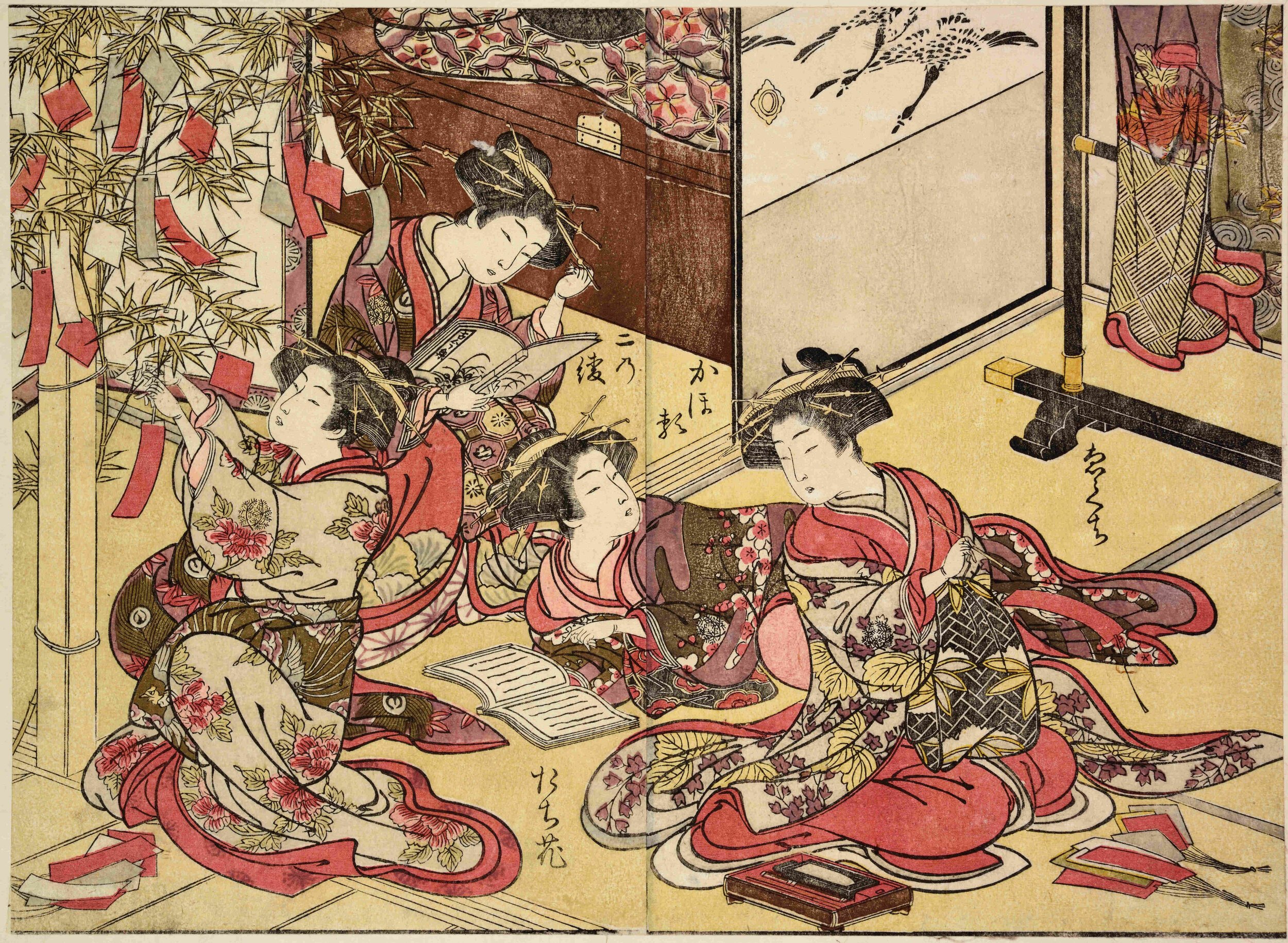Tanabata - An Excursus Through Arts and Popular Culture (Part 1)
10 minutes read
Tanabata 七夕, the Star Festival of the seventh month, celebrates the mythical meeting of two celestial lovers, the weaver Orihime 織姫 and the cowherd Hikoboshi 彦星. This event, nowadays held on the 7th of July as a reminder of the etymology of the word (Tanabata 七夕: Seventh Night), has become one of the highlights of Japanese summers. On this occasion, Japanese people organize festivals (matsuri 祭り) where many gather to enjoy activities and street food, but also, more importantly, to write their wishes on tiny papers to be hanged on bamboo trees. It is believed that wishes expressed on this peculiar occasion are more likely to come true, similarly to what happened in the story of the weaver-girl and the cowherd to which Tanabata is dedicated.
People hanging wishes during a Tanabata festival. On the orange paper in front of the picture can be read the following inscription: Please turn on my switch for motivation to study. © Luigi Zeni
In today’s article and in the next one I am going to present several examples of Tanabata celebrations throughout Japanese history, as well as the adoption of its imagery in Japanese arts and crafts. Our excursus begins in the Heian period (794–1185) with a tanka poem that might have been composed during a banquet celebrating Tanabata. At the time, such events were still a prerogative of the aristocracy, but the story of the two lovers soon became a popular theme in all poetry. We will then jump to the Edo period (1603–1867) when Tanabata was democratized and, thus, celebrated by all social strata. Such tragic tale of forbidden love likely captivated the romance-loving Edo people, as it is partially suggested by the amount of Tanabata-themed artistic productions made, mainly in the form of ukiyo-e prints. Looking at some of these prints gives us a general idea of how this festivity was celebrated at the time. This detour will then be concluded by some examples of modern Tanabata celebrations and also examples from Japanese popular culture.
The Legend of the Weaver Girl and the Cowherd
This legend, influenced by astronomical studies, narrates the tragic story of the stars Vega (the weaver-girl Orihime) and Altair (the cowherd Hikoboshi), whose love was forbidden by heavenly laws. As if those rules were not enough of a deterrent, the noble descent of Orihime, granddaughter of the Heavenly Empress, ruler of the celestial world, further hindered their relation. However, much similar to many such romances, their love was stronger than any social construct, and the two stars frequently met in secrecy. Unfortunately, it did not take long for Heavenly Empress to hear about their forbidden meetings, and her punishment reflected the severity of the celestial rules. The cowherd star was banned to the earthly world, reincarnated as a mortal in a family of farmers, while Orihime was relegated to endlessly weave her magic silk which formed the clouds of the earthly skies.
Position of Vega and Altair separated by the Milky Way. © Stellarium Web Online
With the help of several other stars and gods, the two lovers were able to meet again on Earth, got married and had offspring. Their days were peaceful and joyful until the Heavenly Empress discovered them. It was against the rules of nature for a celestial being to quit their place in the Sky to live on Earth, even more unacceptable if said being was a repeat offender. The furious ruler sent her soldiers to bring back the weaver girl, who was once again forced to live in the sky, but the cowherd ran after them, bringing his two children with him. As they were about to reach Orihime, the Heavenly Empress appeared and, blinded with rage, she created a stream of stars between the two lovers to prevent their reunion. Thus, they were scattered, forever separated by the Milky Way, bound to look at each other in grievance through the starry flow. Their cries and wails moved to pity the whole celestial world, and soon even the Heavenly Empress came to reconsider the gravity of the punishment she inflicted upon the two lovers and their family. In her magnanimity, she allowed Hikoboshi and his children to live in the sky as stars, granting them the possibility to meet with Orihime once per year, during the 7th day of the 7th month. On this merry day a flock of magpies flies across the Milky Way, creating a bridge for the family to be reunited.
Katsukawa Shunʾei (1762 - 1819), Weaver maiden and the ox herder (Kengyū shokujo). Between 1796 and 1815.
Orihime, the weaver princess, standing next to a loom and a man, Kengyuu, the cow-herder, standing next to an ox, both on clouds separated by a gap, with the top of a building visible through the clouds.
© Library of Congress
Tanabata During Heian Period, the Classical Times
This was, in short, the legend that inspired the Qi Xi festival (七夕節), an ancient Chinese ritual of the Han dynasty (206 BC–AD 220) later adopted by the Japanese imperial court sometime between the 7th and 8th century CE. Tanabata was part of an ensemble of Chinese seasonal rituals, similar to what eventually became Hinamatsuri, which punctuated the year based on a lunar calendar. Interestingly, according to the former Japanese temporal division of the year, the beginning of which was set in early spring, Tanabata (7th night of the 7th month) marked the passage between summer and autumn.
Initially sponsored by the imperial family, those seasonal rituals were soon embraced by the nobility as mundane events, namely in the form of important banquets livened up by poetic compositions and readings. During the Heian period began a tradition of of writing poems on mulberry leaves to be offered to the stars, protagonists of the Tanabata celebration. This was due to an association between the paper mulberry (kaji 梶) and the rudder (kaji 舵) of the boat used by Hikoboshi to cross the Milky Way (note: In Japanese the Milky Way is called ‘Ama no gawa 天の川’ which literally translates to: ‘the river in the sky’). Tanabata and its tragic love story seemed to have been particularly cherished by Heian people. Many poets composed about this topic – the theme appears quite frequently even in the Man'yōshū (万葉集 ‘Collection of Ten Thousand Leaves’) first collection of tanka poems compiled approximately in AD 759. In their compositions, poets usually spoke on behalf of Orihime who eagerly waited for Hikoboshi to cross the starry river. This was a peculiar trait of the Japanese conception of this celebration, as in the original story the woman moved towards the waiting man. Such inversion of roles supposedly happened due to different wedding dynamics or, maybe, to further enhance the pathos of the narration.
Below is a tanka poem from the Man'yōshū composed by an anonymous author:
Modern Japanese version
Courtesy of University of Virginia
天地の 初めの時ゆ
天の川 い向ひ居りて
一年に ふたたび逢はぬ
妻恋ひに 物思ふ人
天の川 安の川原の
あり通ふ 出の渡りに
そほ舟の 艫にも舳にも
舟装ひ ま楫しじ貫き
旗すすき 本葉もそよに
秋風の 吹きくる宵に
天の川 白波しのぎ
落ちたぎつ 早瀬渡りて
若草の 妻を巻かむと
大船の 思ひ頼みて
漕ぎ来らむ その夫の子が
あらたまの 年の緒長く
思ひ来し 恋尽すらむ
七月の 七日の宵は
我れも悲しも
Transcription from the modern Japanese version
Ametsuchi no hajime no toki yu
Amanogawa imukaiorite
hitotose ni futatabi awanu
tsumagoi ni mono omou hito
Amanogawa Yasu no kawara no
arigayou toshi no watari ni
sohofune no tomo nimo he nimo
funayosoi makaji shiji nuki
hatasusuki motoha mo soyoni
akikaze no fukikuru yoi ni
Amanogawa shiranami shinogi
ochitagitsu hayase watarite
wakakusa no tsuma ga te makan to
oobune no omoitanomite
kogikuran sono tsuma no ko ga
aratama no toshinoo nagaku
omoikoshi koi tsukusuran
fumitsuki no nanuka no yoi wa
ware mo kanashimo
© The Rector and Visitors of the University of Virginia
Translated from Japanese by The Nippon Gakujutsu Shinkokai
TONIGHT he makes his one journey of the year
Over the Heavenly River, passing Yasu Beach
He, the love-lorn Oxherd longing for his maid,
Whom he can never see but once a year,
Though from the beginning of heaven and earth
They have stood face to face across the Heavenly River.
This evening when the autumn wind arises,
Swaying the pennoned reeds, stalk and blade,
He in his red boat, many-oared
And gaily trimmed, bow and stern,
Buffeting the white waves of the Heavenly River.
And crossing the swift and swirling waters,
Will come rowing - the lone Star-man -
Certain of the bliss
Of his young love's embrace.
So will he sate his year-long want
Tonight, this Seventh Night of the Seventh Moon -
Strangely it thrills my heart !
Envoys
This is the night
When the celestial lovers meet
To undo, the one for the other,
Their girdles of Koma brocade –
Ah, that rapture in the skies !
I think of the happy river-quay
Where the Oxherd, rowing on
Across the stream,
Will come at last
To moor his little boat.
© 1965 Columbia University Press
Tsukioka Yoshitoshi (1839–1892), The Moon of the Milky Way (Ginga no tsuki), from the series One Hundred Aspects of the Moon (Tsuki no hyakushi), September 1886. The lovers of the Tanabata festival.
© 2021 The Trustees of the British Museum
The Democratisation of Tanabata Festivities, the Edo Period
Almost a millennium and several internal conflicts later, Japan reached a period of relative peace, ensured by the strict feudalistic government of the Tokugawa dynasty. During the late Muromachi (1336–1573) and Edo (1603–1867) periods many customs and features of the aristocracy filtrated through the whole society by the means of the now ruling warrior class, as well as thanks to the actions of merchants and artists. Tanabata celebrations were among the many festivities adopted by commoners, and probably one of those that intrigued them the most. By that time, the practice of writing poems on mulberry leaves was replaced by writing them on paper sheets as offerings of prayers to excell in the crafting arts. It is probably during the Edo period that the practice of expressing wishes during Tanabata grew to the point of being intertwined with this event ever after.

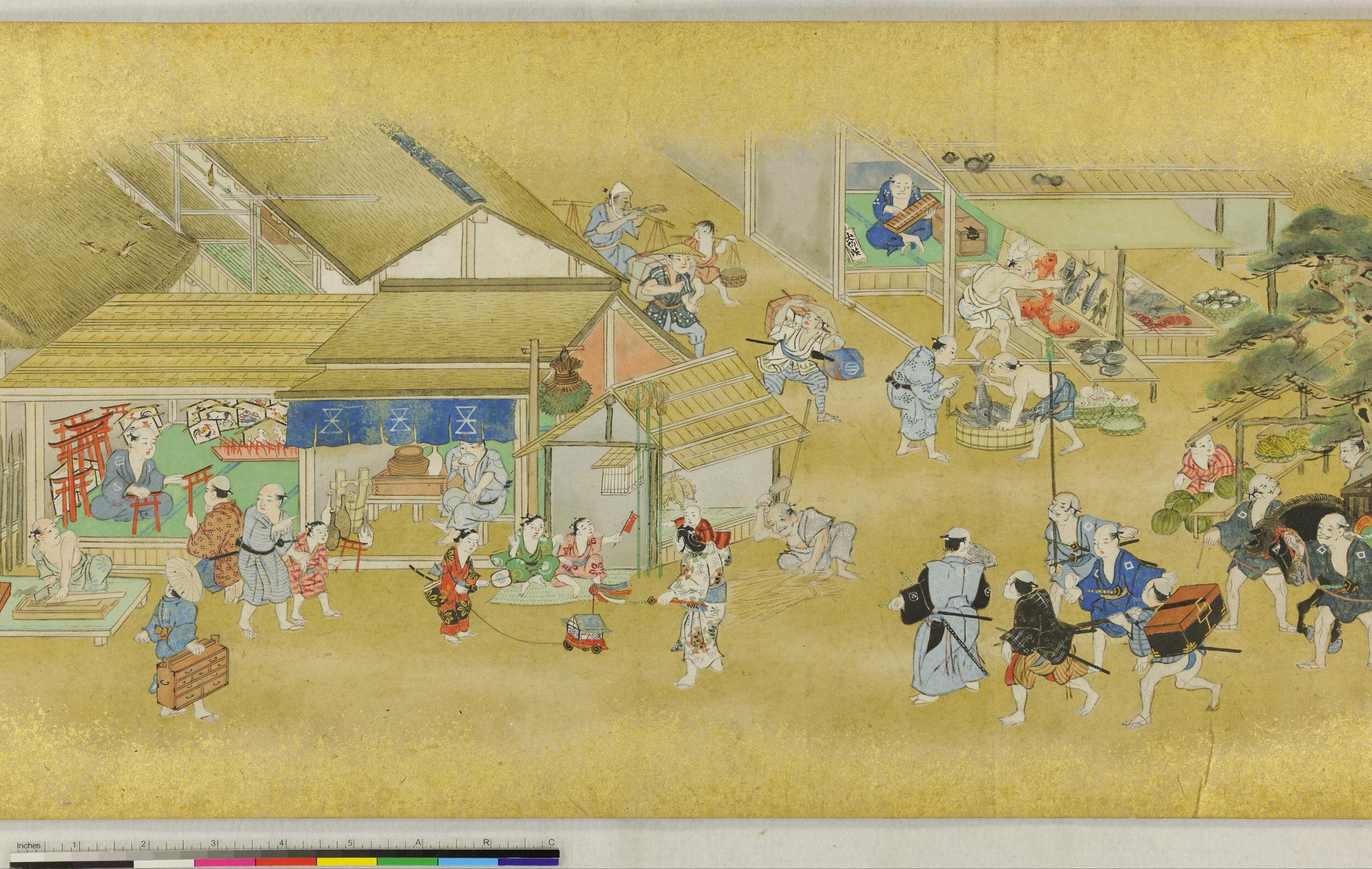

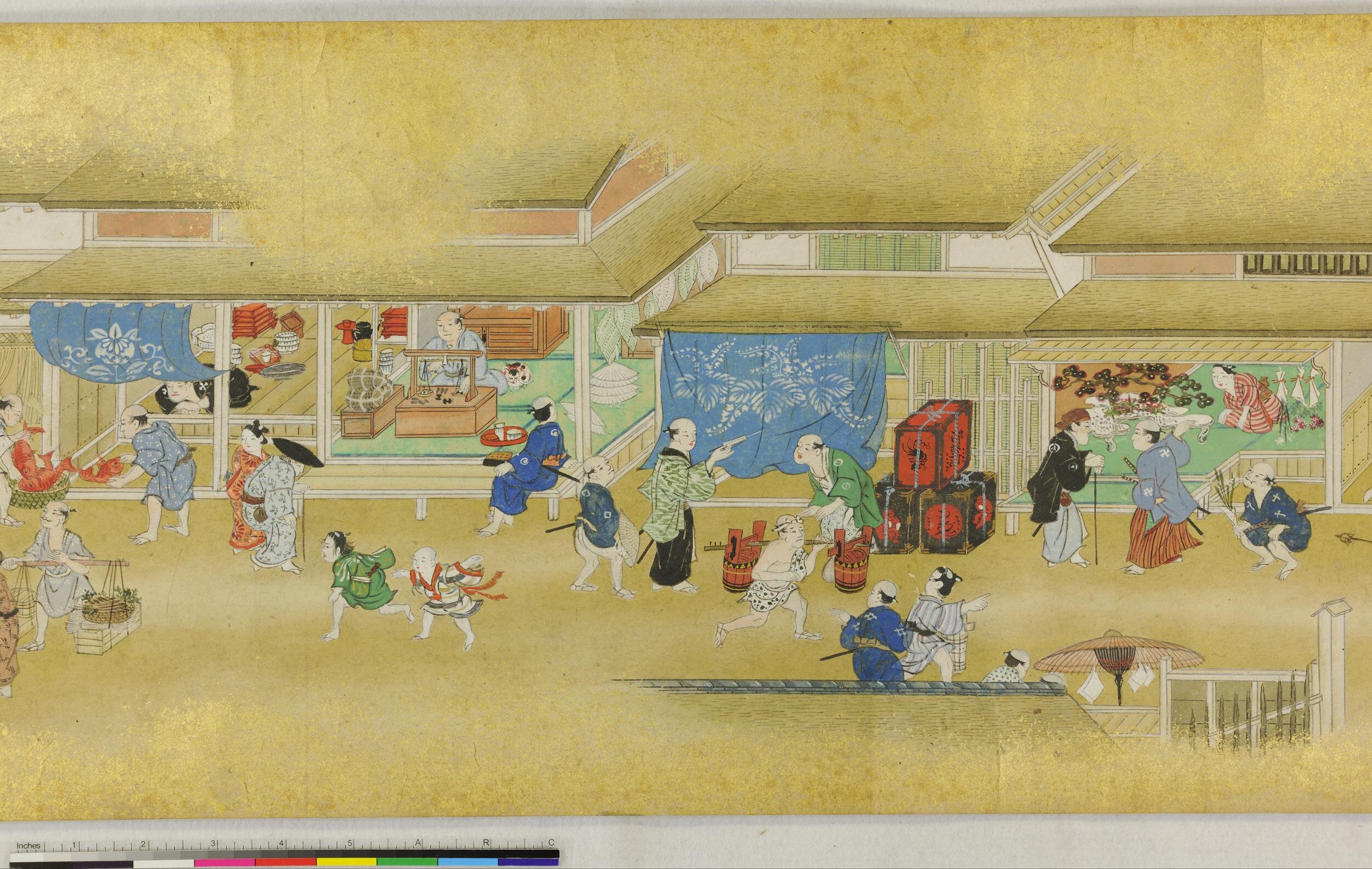
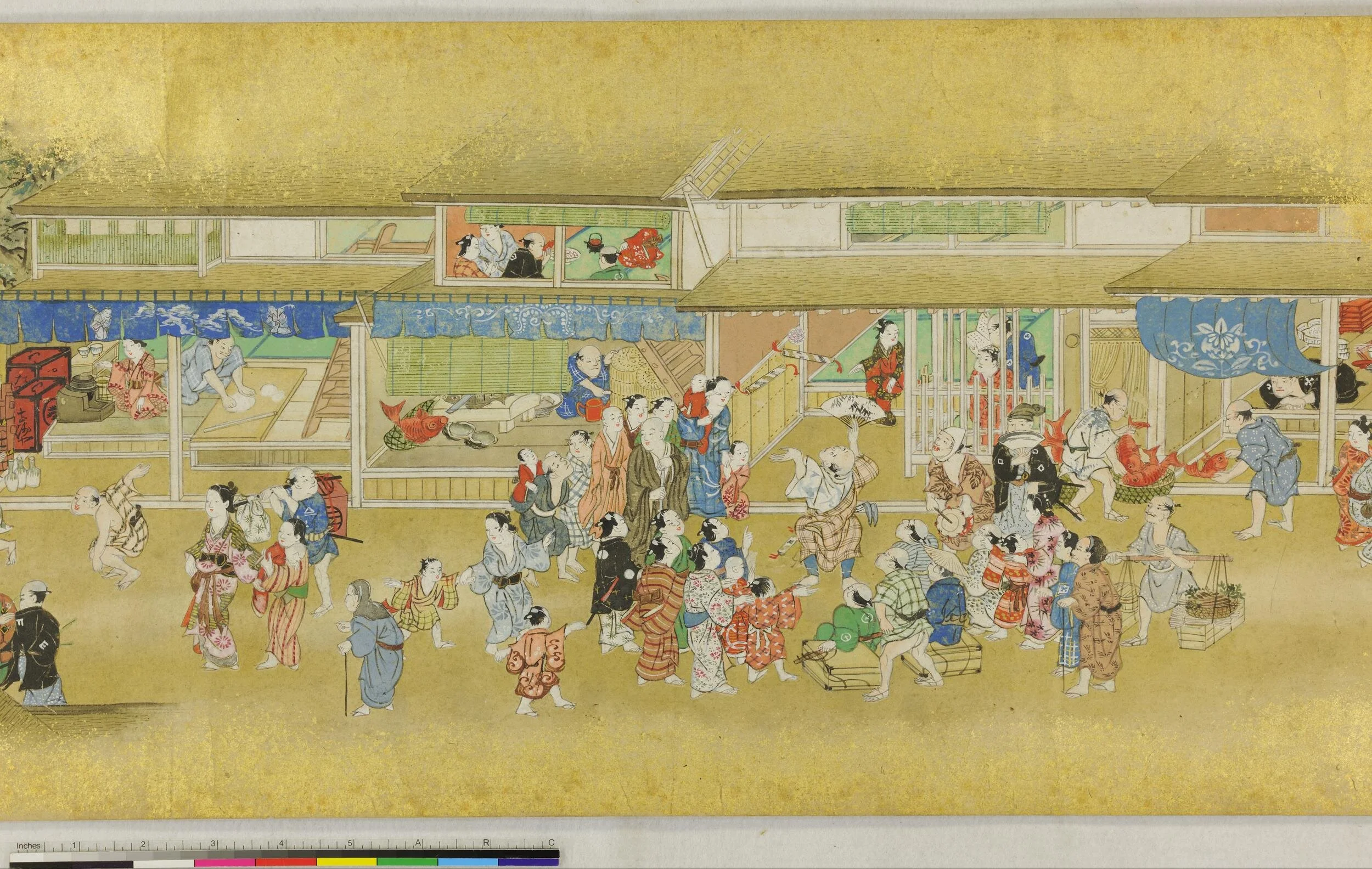

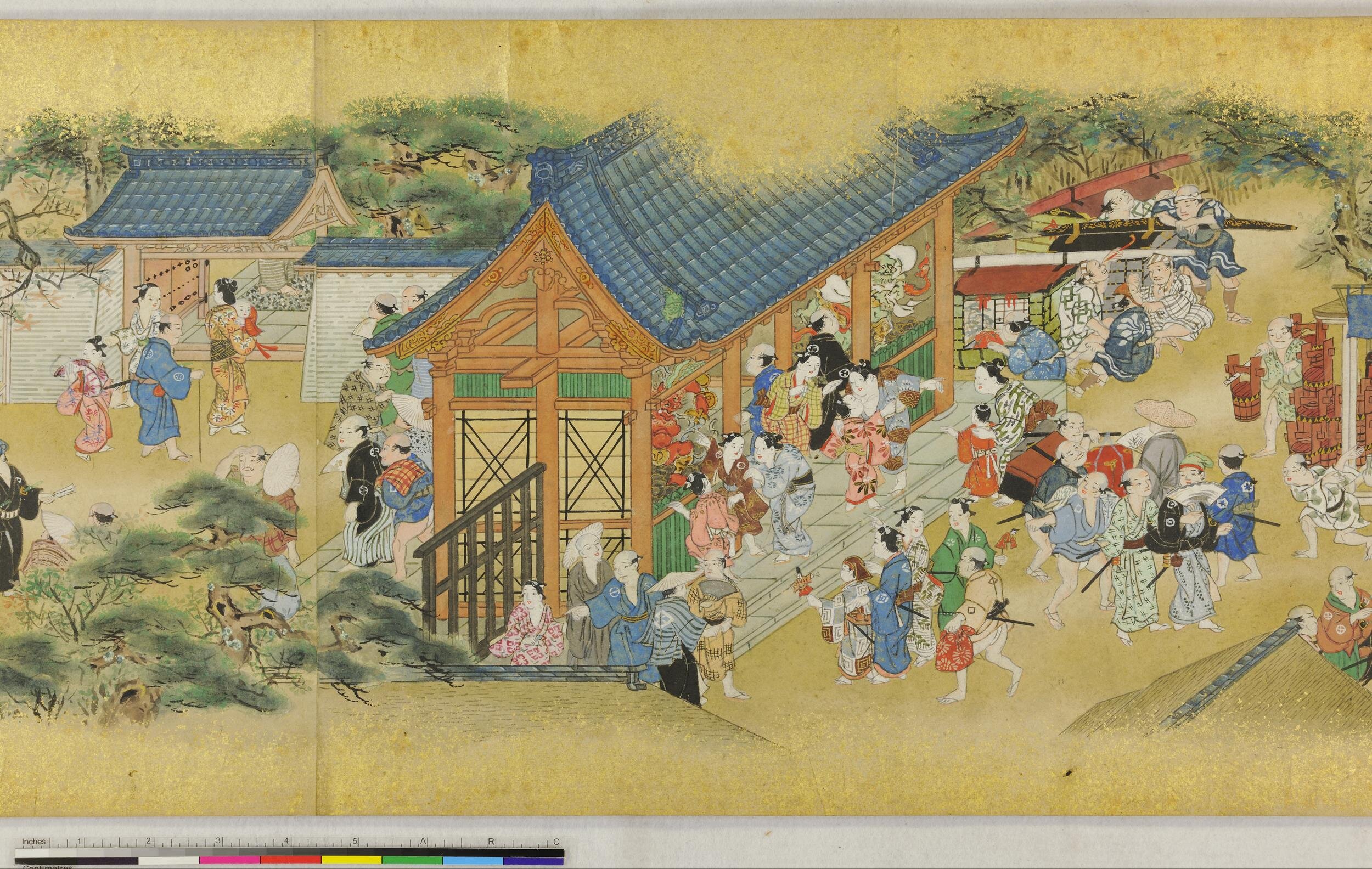
Sumiyoshi Gukei (1631–1705), unnamed painted scroll, 1716–1736, a portion of the painted scroll.
© The Trustees of the British Museum
With this democratisation of previously elitist customs also came a different approach to art, especially woodblock prints, which progressively represented everyday aspects of life. Some suggested that these types of popular objects were conceived as means to teach the masses how to properly celebrate the national festivities. Either way, nowadays we have access to vast catalogues of Edo period prints that suggest what could have been the customs at the time. Therefore, I will gladly give the floor to those popular art pieces, which might speak better about Tanabata than I would ever be able to.
Preparing for Tanabata
Isoda Koryūsai (1735–ca.1790), Making Ornaments for the Tanabata Festival, 1773. © The Metropolitan Museum of Art
Yōshū (Hashimoto) Chikanobu (1838–1912), Chiyoda Castle from the Album of Women, 1895.
© The Metropolitan Museum of Art.
Kids and Tanabata
Torii Kiyonaga (1752–1815), The Tanabata Festival, from the series: Precious Children’s Games of the Five Festivals (Kodakara gosetsu asobi) 1801.
© Art Institute Chicago
Utagawa Kuniyoshi (1797–1861) Tanabata, from the series: Children at Play during the Five Seasonal Festivals (Osana asobi go sekku no uchi), about 1840.
© The Trustees of the British Museum
Kikukawa Eizan (1787–1867), Tanabata, from the series: Fashionable Children of the Five Festivals (Fūryū kodomo gosekku), 1809-29. © 2021 Cleveland Museum of Art
Courtesans and Tanabata
Kitao Shigemasa (1739–1820) and Katsukawa Shunsho (1726–1792), Group of four Yoshiwara women in a room, 1776.
© The New York Public Library
Utagawa Toyohiro (1773–1828), Shichi-gatsu Sanmai-zuzukii, from the series: Toyokuni-Toyohiro Ryoga Juni-ko.
© The Trustees of the British Museum
Celebrating Tanabata
Katsukawa Shuncho, Tanabata Festival, from the series: Amusements of the Five Festival Days (Gosetsu asobi), 1790.
© Art Institute Chicago
Utagawa Hiroshige (1797–1858), Tanabata Festival, from the series: One Hundred Famous Views of Edo, 1857.
© The Metropolitan Museum of Art
Our time has come to an end for today, however, I warmly invite you to stay tuned, as in the next weeks the second part of this diptych dedicated to Tanabata will be published. In the subsequent article I will focus on why Tanabata was an important celebration for emergent kabuki actors, and also present several examples of crafts building upon the theme and imagery of this festivity. We will then part ways with Edo period by pointing out the important changes that Meiji rulers made to the Star Festival, and then conclude our excursus with modern day celebrations, as well as a quick mention of how this event still is relevant in popular culture.
See you very soon!
Written by Marty Borsotti



